This article comes fromMedium, Original Author: STEPN Official
Odaily Translator |
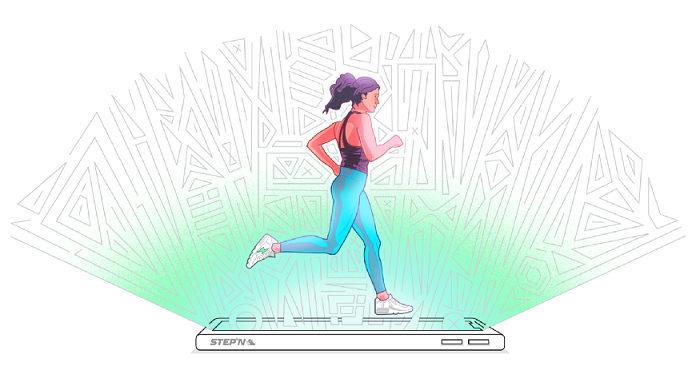
Odaily Translator |
"Earn as you move" Move2Earn games are a new form of Game-Fi where players use their movement data as gamification input and are then rewarded with tokens and NFTs. As early as early August 2021, STEPN had this idea. Although it was not the first project to propose the concept of M2E, STEPN was the fastest project to "realize" this idea (it took only 120 days to complete Product delivery, now the product has been online for two months). Since November 3, 2021, our M2E NFT game has been running on the Beta test network, and we have invited more than 1,000 players from 43 countries to participate, and achieved a weekly player retention rate of over 70%.
This article documents the challenges we faced and how we overcame them.
secondary title
Technical Challenge 1 - Proof of Motion
The original idea was simple: we imported data from wearables and running apps into the game as a form of "proof of motion" and assumed that user data on these platforms could be trusted. Actually we developed a model version within 3 days, but it failed the cheating test on the first day, because we couldn't verify the authenticity of the exercise data, users can easily double their data (carry 2 or more phones will do). In addition, we also found that the running applications and wearable devices do not have a strict anti-cheating system, because they do not need to do so, including users, if it is just pure fitness needs, there is no need to falsify data. But once they get rewarded for moving data, the whole situation changes. If our Move2Earn game does not have a Proof of Movement consensus, the entire token system will quickly collapse. To build a solid POM, we must have a motion data collector for data verification, which can be done by accessing the player's motion sensor data.
1. Gravity sensor
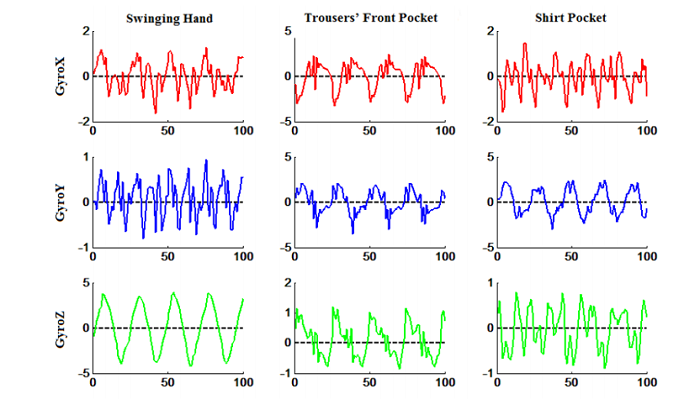
The gravity sensor is the main sensor we use, which provides a 3D vector indicating the direction and magnitude of gravity. Typically, such sensors determine the relative orientation of a device in space. The figure below shows the different motion patterns of the player when carrying the mobile phone. We can observe that these patterns are actually very similar - they are all in a sine wave pattern.
Above: Human motion "wavelength"
To improve the accuracy of motion sensor detection, we also use the following sensors:
·Linear acceleration sensor
· Notable motion sensor
· Accelerometer
·Gyroscope sensor
·Step detection sensor
With these motion sensors in place, we also had to validate all player motion data to make sure it was real people moving. The verification of identity can be accomplished in the following three situations: the amplitude matching of mobile motion with human motion, the matching of mobile motion with mobile pedometer, and the matching of mobile motion with GPS track.
secondary title
Technical Challenge 2 — Proof of Distance
If we are setting rewards based on the number of steps the player makes, then we need to know two things in order to calculate the rewards. The first is how many steps the player has moved, which is very simple for a pedometer; the second is how far the player has moved. At this point, we have encountered the second obstacle - all current civilian GPS devices or applications are inaccurate, ranging from 3 meters outdoors to 20 meters indoors; and there is no product on the market that is accurate accurately measure the distance traveled by a person.
There are three types of GPS errors
1.GPS offset
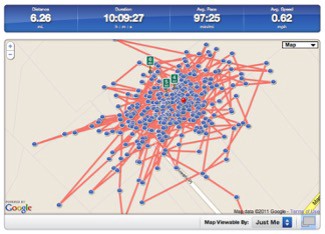
When a mobile device is covered by tall trees or rooftops (indoors), the GPS signal will drift - even if the mobile device is stationary. The graph below shows a GPS device drifting 6,26 miles after being stationary indoors for 10 hours. (This is another reason we can't rely on 3rd party motion data providers - we don't know if 3rd party providers have verified motion sensor data)
Above: Offset results from GPS
2. GPS downgrade
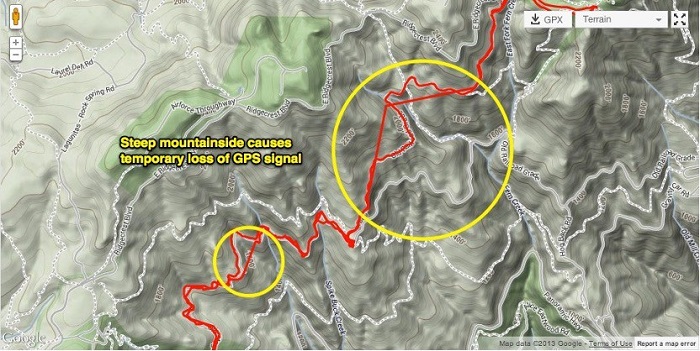
Environmental factors often cause the GPS signal to be lost for a period of time and then reacquired. In this case, the two points before and after the signal loss are treated like any two other subsequent points and connected by a straight line. This will cause the distance information of the user's movement to be less recorded.
Above: Result of signal loss
3. GPS instability

Tall buildings often cause the GPS signal to bounce back and forth between the mobile device and the satellite. This usually results in a "jumpy" GPS track as shown below. And such inaccurate GPS data often results in recording more distance than the player has actually traveled, since every curve on the GPS track has to be calculated with the straight line connecting them.
Above: Results of GPS signal jumps
Currently, there is no ready-made solution for the above problems; we have studied many existing applications and GPS devices, which are affected by these problems. However, we've started doing extended coding and developed an algorithm to tackle this problem. In the latest beta test, our GPS accuracy has been improved by 70 times (through GPS offset correction, environmental factor removal and player route planning algorithm) compared to traditional running apps and GPS devices.
secondary title
Technical Challenge 3 — Prevent hackers from tampering with data
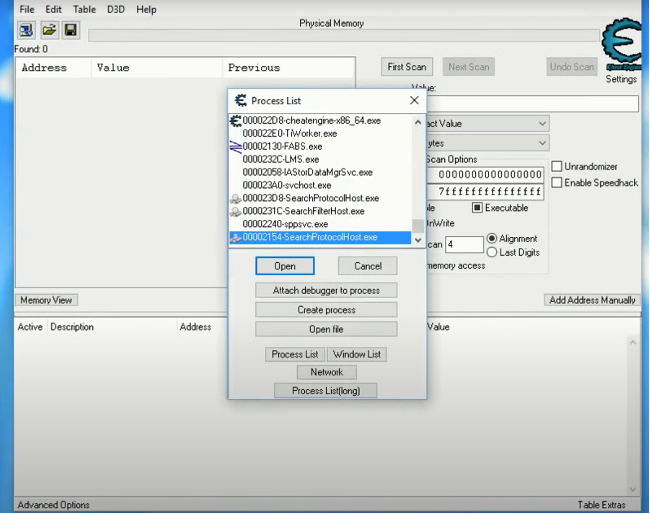
After two months of development, we hit our biggest problem. What happens if a player uses an Android emulator to play the game on a PC, and then feeds doctored movement data to the game through a hacking engine.
We've tried several approaches, but none of them completely solve the hacking problem (including GPS and other movement hacks) without affecting the player experience (such as captcha verification when player movement is random). We have realized that only powerful machine learning is enough to solve the hacking problem. After evaluating our needs, we quickly found talents in deep learning and data supply in a short period of time, and developed the world's first move2earn anti-cheating prototype with 90% accuracy. Not only that, but we plan to expand our player base over the next six months to collect more data to train our system to eventually achieve 99.99% accuracy.
secondary title
Design Challenge 1 - Storage of Game Assets
Occam's razor (Occam's razor) principle is one of the most powerful principles in solving problems in life and in the software development process. Don't waste more things to do, with less things, the same things can be done well."
Therefore, if a game needs to collect and verify motion and GPS data from the player, then the game must be a mobile game, which leads to the first design challenge - where should the game store its assets?
Currently, the options available in the market are very limited. Ideally, in order to enhance the playability of a game, the game must have the following characteristics:
· Smooth user experience (players don't need to jump in/out of multiple apps)
· Happy user experience (fast, cheap and convenient game asset transactions);
· Strong security;
Since there is no ready-made service provider, we must develop a decentralized wallet and Swap completely customized for our own game. So we chose the Solana blockchain to build our game. The Solana blockchain is currently one of the few public chains in the crypto market that offers low transaction costs and has its own NFT protocol. In addition, we can also access decentralized trading platforms such as Orca/Raydium to provide liquidity for our in-game Swap; players can use the swap function of the in-game wallet to convert game/governance tokens into assets such as SOL/USDC and withdraw them to the exchange.
secondary title
Design Challenge 2 - Build a Persistent Reward System
While everyone has accepted the Play2Earn model, we have also accepted the Play as Work model. When we analyzed the reasons why people don't play games, use apps, or even work, we found that getting a good reward is not always the main motivation for people to keep working. In fact, people leave high-paying jobs when they don't get respect, love, and self-actualization (this is actually Maslow's Hierarchy of Needs). This discovery made us rethink token design; we needed a game that not only attracted millions of players through tokens, but also retained them over time. Therefore, we also designed the three levels of the economic model similar to Maslow's hierarchy of needs.
1. Currency level
Monetary income is the first layer, and usually this is what people talk about the most, namely token economics. To put it simply, we need to design game mechanics to drive demand and manage supply; when the demand for tokens exceeds supply, the market will set a price for tokens, and players can get currency rewards through movement.
2. Social level
The next level is social. As social animals, human beings have an inherent need to socialize. We express emotions to each other and can be multiplied through network effects and enhanced through affirmative action. Players can gain social recognition, attention, and even deepen their relationship with each other through games. Earn social rewards through powerful integration of our games with established social media and networks. To this end, we will design some very Web3 social scenarios in the future and empower our token economics accordingly.
Similar to the social dimension, personal achievement is another motivator for players to stay. We’ve seen higher user retention rates for apps with built-in achievement systems than those without. Asking the player to set a goal and keep working towards it will give the player a sense of satisfaction and accomplishment. At the same time, an application with an achievement system will also benefit the user's physical and mental health. The deeper the social connections and achievements a player makes in the app, the harder it is to leave the game.
secondary title
Design Challenge 3 - How to Curb Inflation?
It is undeniable that Axie Infinity has expanded the "earn while playing" P2E beyond the encrypted community; by carefully analyzing the SLP economic model of Axie Infinity's native token, we have clearly identified where the challenges of game token design are - if the game token There is no upper limit to supply, so how to balance supply and demand? From Keynes to Hayek, from token circulation to network effects, we have research. we discover:
“The unified minting of game tokens must be managed by the unified burning of game tokens to convert them into different forms of assets, which conversion can be voluntary, mandatory or structured.”
"The temporary minting of game tokens must be managed through the consumption of game tokens to create value beyond currency."
STEPN has designed various "token application scenarios" for paying players. For example, our gem system will allow people who want to spend money to fully burn their tokens; we also take care of players without NFT and provide them with The window, which is our leasing system, will give us the opportunity to allow non-blockchain users to participate in our game.
secondary title
Design Challenge 4 - NFT Value Discovery
1. Uniqueness vs. Rarity vs. Scarcity
Let’s start by looking at what the definitions of uniqueness, rarity and scarcity are:
- Uniqueness - unique.
- Rarity - only a very small number.
- Scarcity - when the demand for something is greater than the supply.
Once we understand the above definitions, we will find that scarcity is actually a relative concept, as long as there is more demand than supply, it will become scarce; only when something is scarce, rarity and uniqueness will have value. Therefore, we split the NFT design into two layers, making it a Veblen Good. The first layer is Utility Good, NFT running shoes are useful; the second layer is Veblen Good, NFT running shoes can be amplified through our social elements and running shoe customization elements, and become a tool for showing off.
(Odaily Jun Note: Veblen commodities, also known as ostentatious wealth, are used in economics to describe a commodity, which is characterized by a positive relationship between commodity demand and commodity price, rather than the reverse relationship of the normal law of demand. This kind of commodity can To satisfy human vanity is to show off wealth and status, so it is called conspicuous consumption.
2. NFT price discovery
In order for STEPN's NFTs to be scarce, it was first necessary to choose what items would be needed to make the main NFT we used in the game - our answer, obviously, was sneakers, since sneakers are the most relevant and essential when running Less items. In order to drive our demand for NFT, we turned it into a mining machine, a mining machine that you can customize, upgrade and even "breed" (this is actually exactly the advantage of Web 3.0). Each player must own NFT running shoes to receive token benefits; the more sneakers they have, and the higher the level of those sneakers, the more rewards they will receive. There will never be enough running shoes, "breeding" running shoes has a cooling time, burning tokens, and tokens also take time to accumulate.
Once we address the scarcity of NFT sneakers, STEPN’s “5-quality System” (five major quality systems) will address the rarity – from normal sneakers to legendary sneakers; the higher the quality of the sneaker, the higher the quality of the sneaker” The better the performance of "mining", of course, the more difficult it is to obtain this kind of sneakers. The uniqueness is solved by the sneaker series number, the first 10,000 NFT sneaker numbers, after 10,000, the sneaker series number will be random. The first 10,000 sneakers will always be unique, while sneakers №1 to №1,000 will be awarded to our early adopters.
secondary title
Build a strong competitive "moat"
In addition to being the first mover in the new track of earning while you move, proof of motion, proof of distance, and hack prevention, we have built several competitive moats.
1. AI system for detecting cheating and hacking (AI music)
Through our development of an AI system that detects cheating and hacking, we have also created an AI-generated music background for the player; the music will be randomly generated based on the player's running pace.
2. Carbon neutrality
We always believe that a great crypto-native project should also be a great social justice experiment. Therefore, the profits of our game are voted through the DAO; governance token holders decide what percentage of the game's profits are used for carbon neutrality and how much is paid to the governance token holders. The more tokens are rewarded; the more paid out as dividends, the more their governance tokens will be burned as a penalty.
3. Social integration of location-based services (LBS)
Because of the time we spend correcting GPS errors, we've become experts in this field. In fact, we've also developed a Location-Based Services (LBS) integration with Discord. When players unlock certain game milestones, they are assigned to sub-channels on our Discord; for example, player A runs 100km in Sydney, player B mints 100 sneaker NFTs in Sydney, and they are each "distributed" Register" to High milage Club Sydney and Shoe Tinker Club Sydney.
4. Connect tens of millions of non-cryptocurrency runners
We also made the game accessible to non-crypto players, which we believe will be key to growing STEPN games to massive players. Therefore, we built an automatic matching system, where crypto players with multiple pairs of NFT sneakers can rent them out to non-crypto runners, and the proceeds will be shared between the two.
5. Scalable game server
As an established game developer, we know that the most critical requirements of the game business are the real-time and high concurrency support capabilities of server-side logic processing. Game servers have to deal with high concurrent data synchronization (state or frame). Therefore, we built a scalable game server for the "move and earn" NFT game, with an initial server capacity of 100,000 syncs (1 million active users).
6. Embrace Vampire Attack
In our early demonstration, we proposed that the biggest killer feature of Move2earn is the vampire attack. We have seen this in the development process of Axie Infinity. When Axie Infinity proves that the concept of Play2Earn is indeed feasible, a large number of imitators will be like this mushrooming. For a game project that needs to be played while sitting in front of a computer, this is not the worst thing, because for computer games, a player can only play one game at a time. In the Move2earn mode, players can "multi-open" and mine multiple projects at the same time, which will greatly dilute the competitiveness of Move2earn's head project - other projects will mine users of this project Vampire attack means that these players can be leveraged to "double dig" or even "multiple dig" with very little marketing expenses.
We initially regarded this model as a scourge, and even wanted to deploy algorithms to avoid double mining. But when we opened up the pattern, we found that we should not stop it, but even welcome it. We should even take the initiative to invite new projects to cooperate with us for joint mining. We have been exploring this model recently. Possibilities, starting from cooperation with other projects.
Lifecycle Challenge - Transition from Game to Running App
secondary title
in conclusion
in conclusion
Frankly speaking, it is extremely challenging to complete an original product delivered by an innovative concept in a short period of time.
As of January 16, 2022, we have successfully developed and operated the core elements of M2E, the anti-cheating system, and a complete set of blockchain vertical industry chains - wallet, swap and market, all built in one application .
In the process of development and promotion, we have summed up experience and found that we can have greater development, so we decided to make strategic track adjustments to the project; if the M2E model is verified to be feasible, even if we will see new projects in the This track layout, but STEPN will build a strong moat, and lead the development direction of this industry by building user stickiness and excellent execution.